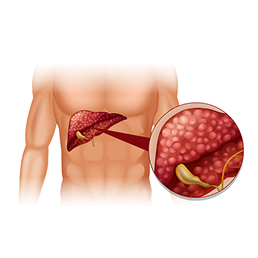Bile duct cancer is a rare and aggressive type of cancer that often develops silently—showing few or no symptoms until it reaches an advanced stage. In many cases, early diagnosis is missed, which can limit treatment options and impact outcomes.
At King’s Liver Transplant Centre of Excellence, we are committed to providing world-class duct cancer treatment in Dubai, focusing on early detection, accurate diagnosis, and advanced, multidisciplinary care.
Our goal is simple: Catch it early, treat it with precision, and give patients every opportunity for a better future.
Understanding bile duct cancer
Bile duct cancer, or cholangiocarcinoma, is a rare and aggressive form of cancer that starts in the bile ducts—the slender tubes that carry bile, a digestive liquid from the liver and gallbladder to the small intestine.
Bile duct cancer is classified based on its location:
- Intrahepatic cholangiocarcinoma – Starts in the bile ducts inside the liver.
- Perihilar (hilar) cholangiocarcinoma – Occurs at the junction where the right and left bile ducts merge and exit the liver.
- Distal cholangiocarcinoma – Forms in the bile ducts outside the liver, closer to the small intestine.
- Multiple cholangiocarcinomas – Multiple tumours arise from different regions of the bile duct.
Symptoms to watch for
Early-stage bile duct cancer may not cause noticeable symptoms. As it progresses, common symptoms include:
- Jaundice (yellowing of the skin and eyes)
- Abdominal pain
- Unusual weight loss
- Nausea and vomiting
- Fatigue
- Dark urine and pale stools
- Itchy skin
- Night sweats
- Fever (in some cases)

Diagnosing bile duct cancer
At King’s Liver Transplant Centre of Excellence, we understand that early and accurate diagnosis is key to improving outcomes in bile duct cancer. Our advanced diagnostic protocols are designed to detect the disease at the earliest possible stage:
- Liver Function Tests: Identify bile duct blockages and liver performance.
- Tumor markers (CA 19-9, CEA): Help support the diagnosis.
- Imaging (Ultrasound, CT, MRI/MRCP, PET): Visualise tumours and assess spread.
- Biopsy: Confirms cancer through tissue sampling.
- ERCP: Examines bile ducts, collects samples, and places stents if needed.
Trust our team of some of the best bile duct cancer specialists in Dubai for precise and timely diagnosis.

Bile duct cancer treatment in Dubai
Surgery
Surgery is the only curative option for bile duct cancer, aiming to remove the tumour and surrounding tissue completely.
Depending on the stage and location, this may include resection of the bile duct, part of the liver, or nearby organs.
Chemotherapy
Chemotherapy is a supportive treatment that aims to destroy cancer cells.
It may be given before or after surgery to shrink tumours or reduce the risk of recurrence or as a primary treatment in advanced stages where surgery is not an option.
Radiation therapy
Radiation therapy is another treatment option for bile duct cancer. This therapy uses high-energy beams to target and destroy cancer cells.
It may be administered alongside chemotherapy or following surgery to help minimise the risk of the cancer returning.
Immunotherapy
Immunotherapy works by enhancing the body’s immune system to detect and attack cancer cells.
It may be suitable for advanced or resistant forms of bile duct cancer, and can be combined with chemotherapy treatment.
Photodynamic therapy
This minimally invasive treatment uses light-sensitive drugs combined with laser light to target and destroy cancer cells within the bile ducts.
It can help relieve symptoms and slow cancer growth in unresectable cases.
Liver transport
A liver transplant is a relatively new bile duct cancer treatment.
It may be considered when the tumour is localised and cannot be safely removed through conventional surgery, but it can be entirely addressed by replacing the liver.
Biliary drainage
Bile duct cancer may result in a blockage. This happens when the tumour presses against the tube, allowing bile acids to drain from the duct.
Biliary drainage focuses on helping bile drain properly from the liver into the small intestine. This is often performed through ERCP or image-guided techniques.
Palliative care
Since bile duct cancers are usually diagnosed at an advanced stage, curative options may not be viable.
In such cases, the focus shifts to relieving symptoms, improving quality of life, and providing comprehensive supportive care—including emotional, nutritional, and medical support.
King's liver transplant centre of excellence: Leading bile duct cancer treatment in Dubai
Affiliated with King’s College Hospital London, one of the world’s foremost liver and cancer centres, King’s Liver Transplant Centre of Excellence delivers internationally acclaimed care for bile duct cancer right here in Dubai.
Our multidisciplinary team—including some of the best bile duct cancer specialists in Dubai—offers expert, compassionate care across the full spectrum, from early diagnosis and advanced imaging to surgical treatment, liver transplantation, and supportive therapies.
Take control of your health with world-class, personalised cancer care.
FAQs
Risk factors include chronic liver disease, primary sclerosing cholangitis, bile duct abnormalities from birth (e.g., choledochal cyst), liver fluke infections, diabetes, smoking, and certain inherited conditions like Lynch syndrome or cystic fibrosis.
Bile duct cancer staging is based on the size of tumour, whether it has spread to lymph nodes or organs, and if it has metastasised to distant parts of the body. Imaging tests and biopsy results help determine the stage, ranging from stage I (early) to stage IV (advanced).
Surgery is the only potentially curative option, especially if the cancer is detected early and fully removed. However, many cases are diagnosed at a late stage, where treatment focuses on controlling the disease and improving the patient’s comfort and longevity.
Yes, bile duct cancer can spread to nearby lymph nodes, liver tissue, or distant organs like the lungs. This is called metastasis. The extent of spread helps determine the cancer’s stage and influences treatment decisions and prognosis.


